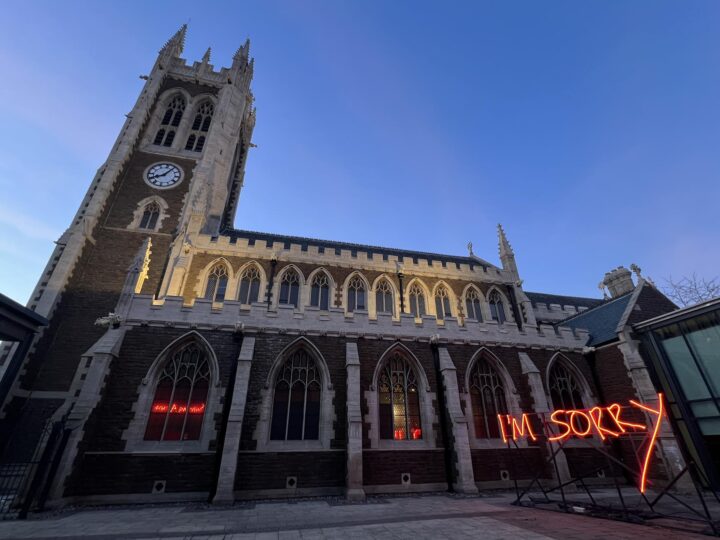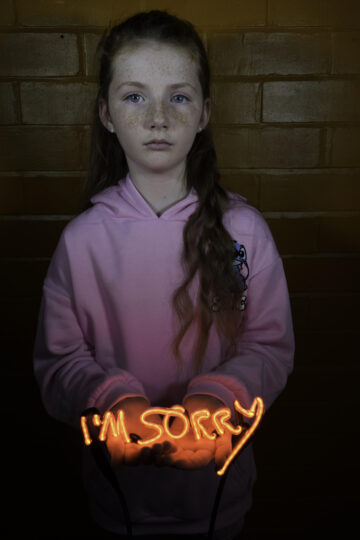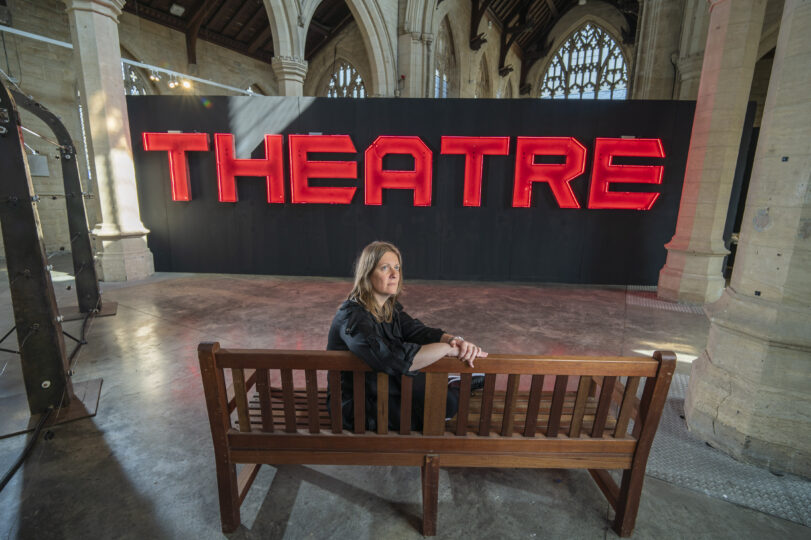18/06/25
Annabel McCourt: I’m Sorry – Retrospective
20-21 Visual Arts Centre, Scunthorpe, supported by Arts Council England in conjunction with Barnsley Civic
12 April – 5 July 2025
I grew up with Section 28. I wasn’t allowed to speak in an Amnesty International assembly for 11- to 14-year-olds about death sentences being given to homosexuals around the globe. I joined in with and rallied for a boycott of Stagecoach, when the company’s chairman, Brian Souter, financially supported a campaign against the section (ultimately successfully) being repealed. I celebrated when first civil partnership and then equal marriage rights were granted to gays and lesbians. What I absolutely never would have suspected would be for an exhibition, by an openly gay artist, with works responding to well- and lesser-known LGBTQIA-rights breaches, as well as more general human-rights wrongs (Donald Trump has a starring role), would be threatened with being pulled, days before installing, due to the ‘threat’ it posed to being misappropriated by the Reform UK party in local mayoral elections. Thankfully (for this exhibition, if not more generally), the artist behind it all, Annabel McCourt, had been here before. In 2020, she had two of her flags from the special commission Flying the Flag (2020) censored at the then Collection and Usher Gallery in Lincoln 48 hours before her exhibition opening. The Section 28 flag was banned outright, and the Equal Marriage one was ‘adapted’ by removing the voting numbers. So, to come back to the present day, when her current exhibition was under threat, McCourt firmly stood her ground, seeking urgent clarification. ‘There was no way on earth this was going to happen again,’ she says. ‘In 2025, in my home county, my first retrospective, because people were worried about how it might be received and whether it would influence voting or not.’ Luckily, McCourt also had the support of Arts Council England, since I’m Sorry (2023), a multi-part work that forms part of this retrospective, is set to undertake an ACE-funded tour of multiple venues across the north of England. As a result, the exhibition was installed, and the former church, now the arts centre 20-21 Visual Arts in Scunthorpe, has been transformed into an unsettling, dystopian, neon-lit parallel universe – or, as one teenage boy suggested on the opening night, ‘the set for a Netflix horror show’. ‘It’s brutal. But it’s a cruel and nasty world,’ says McCourt.

Annabel McCourt, I’m Sorry – Retrospective, 20-21 Visual Arts Centre, Scunthorpe, supported by Arts Council England in conjunction with Barnsley Civic © the artist
I’m Sorry is doubtless the key work in the exhibition, and it is what greets visitors, with a large neon in the centre’s open courtyard, visible as they arrive at the venue, then a slightly smaller neon as they walk through to the gallery space, and a wall of photographs of people holding an even smaller, portable neon of the phrase. This was really the springboard for the piece as a whole. Having begun with the idea of multiple ‘I’m Sorry’s in a white-cube-style space, ‘almost like an infinity mirror of hell,’ McCourt asked her collaborators, Neon Workshops, what the smallest they could produce the phrase would be. Her mind raced with ideas of a user-friendly ‘I’m Sorry’, and soon she was welcoming friends and strangers alike, to her studio as well as to darkened venues such as a nearby forest, to be photographed (McCourt started out life as a photographer) holding the mini – low-voltage – artwork, formed from her own intricate handwriting, thinking about what they were sorry for. The results are mixed. Some look sincere to the point of tearfulness, the words reflecting their luminosity in the subject’s dark and widened teary pupils, while others’ wry smiles give them away as distracted or not genuinely repentant at all. Similarly, in the church tower, the ‘I’m sorry’ statements on a blackboard, written by visitors to the show, range from the flippant ‘I’m sorry I’m tall’ to the shudder-provoking ‘I’m sorry you took advantage of me. I was a child’. These apologies are offered up and ascend the tower, greeted by another large, deconstructed neon I’m Sorry hanging above. It is certainly poignant and fitting, making your heart skip a beat as you consider what your own I’m Sorry would be (and, if you’re brave enough, wait for a solitary moment to add it to the board). The final part of this work, at least for this iteration, is a small vitrine with an inverted, mini ‘I’m sorry’ neon, positioned at an appropriate height, in front of a full-length mirror, such that visitors can ‘hold’ the words for themselves (and take a good selfie for Instagram, of course!).

Annabel McCourt, I’m Sorry, 2023 © the artist
Another key work in the politically-steeped retrospective is Electric Fence (2017-25), originally commissioned for UK City of Culture, Hull 2017. McCourt likes to employ this piece to make an architectural intervention, forcing visitors to stop and think about how to proceed. Here, two opposing fences bisect the gallery, offering a walkway between them, quietly controlling the flow of people, causing an interruption and inconvenience. The visitor is invited to touch the ‘electric’ wires, in turn eliciting a painful soundtrack – the sound of hate – which vibrates the whole gallery. The steel posts, shivering like tuning forks, are blotchy with patches of patina, their welded scars visible, like the scars of those harmed (not to mention exterminated) at camps across the world. The piece was made in response to the American pastor Charles Worley’s hate-filled and -fuelled rant about wanting to electrocute ‘lesbians and queers’, terrifyingly as recently as 2012. It should be noted, especially in the context of the threat to this exhibition, that this particular work was shown, to resounding success, at Laboratoire Agit’Art, Dak’Art Biennale, 2018, in Dakar, Senegal, where it remains a crime to be a homosexual.

Annabel McCourt, Theatre of War, 2020/25, photograph by Richard Walker/ImageNorth
Running the length of the fence is the taller-than-life word, THEATRE, lit with red LEDs, and sourced (via fabricators) from the Stephen Joseph Theatre in Scarborough, when it was being renovated. Facing it, a park bench bears the inscription: ‘Sit here and do nothing’, inviting the visitor to contemplate whether they would risk their lives to speak out, or simply stand by and let the atrocities continue. This installation, Theatre of War (2020/25), was originally shown alongside McCourt’s replica military drone control station, REMOTE (2020), which is included in miniature here, referencing the fact that Lincolnshire is known as ‘bomber county’ for its RAF bases and ground control stations.
Like a magpie, McCourt has also sourced (courtesy of ebay) a smiling rainbow from the Rainbow Roundabout in Skegness. This is installed, along with a tiny neon cloud, as Happy Sad (2019), above MAGA Grabber (2019), a transformed arcade claw machine, in which the ominous outline of Trump invites you to attempt grabbing one of the cats (‘literally screaming pussies’) or emblazoned caps contained. ‘It’s probably the most disgusting thing I’ve ever made,’ says McCourt. An absolute stickler for detail and authenticity, the caps were produced in China, in the exact same factory (tracked down by McCourt) as the merchandise for Trump’s MAGA campaign. The familiar music of an arcade game is altered to play the Star-Spangled Banner and the Chinese national anthem. The words on its side and in the audio are taken from Trump’s notorious brags about ‘grabbing them by the pussy’ and ‘nobody builds a wall like me’, and the joystick is positioned, well, let’s just say, strategically. From the outset, if you pay attention, you are destined to fail with this ‘game’. The ‘licence’ states: ‘This machine is category F (fake)’ and the text at the top of the box shouts out: ‘LOSER EVERY GAME’. McCourt made the work during Trump’s first term. She is, naturally, horrified, that it has become even more relevant today. ‘Never in my wildest dystopian nightmares would I have imagined that Trump would be president again now. But the cover’s off, it’s wheeled out again, and it’s probably more pertinent than ever.’
Dotted in between these key works are a number of film pieces and documentation of other public artworks. For example, test pieces and the leaflet for Murmuration (2020), a community-focused public artwork comprising tiny copper silhouettes, from photos taken during lockdown, arranged in the wave-like manner of a fortune fish; photos from a T-shirt project at São Paolo Pride in 2022 in which the participants could align themselves to spell out different ‘poems’; two further large-scale neons, Suffering Arcadia (2019) and Happy Hour in the Harmful Factory (2019); and the short film Delphine (2012), about the sea falling in love with an eccentric marine biologist.

Annabel McCourt, Per Ardua, 2025 © the artist
The crowning piece of the exhibition is Per Ardua (2025), created and installed after the opening, responding to the army’s longstanding (but thankfully now defunct) ruling against homosexuals in its ranks, and marking the 25th anniversary of this ban being lifted. The white neon spiral with a central rainbow, which emulates an RAF roundel (a circular identification mark painted on aircraft to identify them to other forces) but could easily be taken for a contemporary rose window, repeatedly spells out the words ‘per ardua’, part of the RAF’s motto, ‘per ardua ad astra’, which means (in Latin) ‘through adversity to the stars’. The second clause is found at the centre of the piece, suggesting its attainability, yet the irony is, says McCourt, striking out the handwritten neon text, that it precisely was not attainable for the many thousands of homosexuals wanting to join up over the years, nor for those who did join up and had to hide their identities and/or deal with bullying and psychological trauma. Herself, growing up in rural Lincolnshire, desperate to escape the confines of a small, east-of-England town, set to the soundtrack of A-10 Tank Buster gunfire at RAF Donna Nook bombing range, the artist, who also has a love of aeroplanes, briefly considered enlisting for army, but wasn’t prepared to betray her true self. To have this exhibition go ahead, and for today’s youth of the region to recognise its content as ‘horrific’, is far more than a personal success. McCourt’s work has the power to educate, to change minds, and maybe, yes, to influence elections. In a region where Reform UK’s Dame Andrea Jenkyns secured a resounding victory to become Greater Lincolnshire’s first elected mayor, this would be no bad thing.